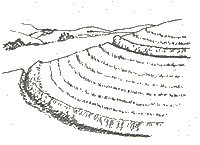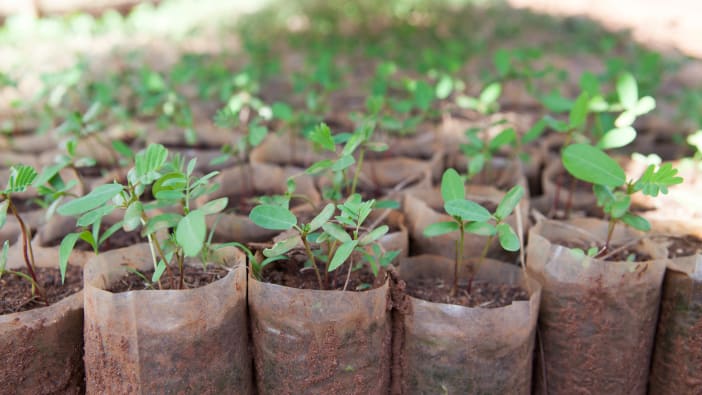by Mike Carter.
Imagine you need to push a loaded cart down a gentle slope. You first have to get the cart moving - this may need quite a hard push. Once the cart is moving, a steady, gentle push may keep it moving down the slope. Getting the cart moving in the first place takes a lot of effort - keeping it moving is easier.
This picture may help in understanding and controlling soil erosion. If soil particles are being eroded down a slope, something must first provide the push, firstly to get them moving and, secondly to keep them moving down the slope. With wind erosion, a strong gust of wind may lift soil off the ground - then a more gentle wind may be enough to keep it moving in the air for very long distances.
With erosion by water, the farmer faces two enemies...
Two enemies
Rain drop impact
The force of rain drops hitting the soil causes splashes that lift soil particles into the air. It also breaks up larger soil clumps into small ones, easier to move. Rain splash also makes the soil surface smooth, filling cracks with clay - water can then only penetrate such a surface slowly.
Run-off
Run-off is the water that moves over a sloping soil surface. This happens when the rain is falling faster than the rain can be soaked up into the soil. The faster run-off water moves, the more soil particles it can carry. How fast the water flows will depend, in turn, on how steep and how long the slope is.
Two solutions
Soil cover
Cover the soil as much as possible. Anything that can absorb the energy of raindrops will help - especially at the beginning of the rainy season, when storms are usually at their worst and the soil is often bare.
The cover needs to be close to the soil surface to protect it. For example, the leaves of tall trees give little protection. The leaves of a low lying shrub protect the soil surface well.
Barriers
Stop water moving down the slope or slow the water down so it cannot carry so much soil.
Anything that makes the soil more level, or that divides a slope into shorter lengths, will reduce run-off speed. Slower moving water causes less erosion - it also has more time to soak into the soil.
In areas with heavy storms, build strong barriers and create controlled waterways to channel excess water to safety.
Control methods
Cover methods
Mulching
Cover crops and green manures
Inter-cropping and mixed cropping
Early planting
Crop residues
Agroforestry
Minimum cultivation
Barrier methods
Contour grass strips
Contour hedges and trees
Contour ploughing
Contour ridges and ditches
Contour crop planting
Contour trash lines
Terracing










